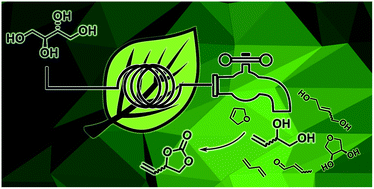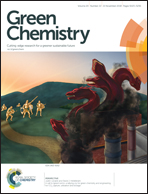A versatile biobased continuous flow strategy for the production of 3-butene-1,2-diol and vinyl ethylene carbonate from erythritol†
Abstract
A versatile, tunable and robust continuous flow procedure for the deoxydehydration (DODH) of biobased erythritol toward 3-butene-1,2-diol is described. The procedure relies on specific assets of multistep continuous flow processing. Detailed mechanistic and computational studies on erythritol show that either 3-butene-1,2-diol or butadiene are obtained in high selectivity and yield on demand, as a function of the DODH reagent/substrate ratio and of the process parameters. Short reaction times (1–15 min) at high temperature (225–275 °C) and moderate pressure are reported. 3-Butene-1,2-diol is then further converted downstream into its corresponding carbonate, i.e. 4-vinyl-1,3-dioxolan-2-one (vinyl ethylene carbonate), an important industrial building block. The carbonation step uses a supported organocatalyst, and could be directly concatenated to the first DODH step. This unprecedented procedure also relies on a unique combination of on- and off-line analytical protocols for reaction monitoring and product quantification, and offers a biobased strategy toward important industrial building blocks otherwise petrosourced.

- This article is part of the themed collection: 2018 Green Chemistry Hot Articles


 Please wait while we load your content...
Please wait while we load your content...